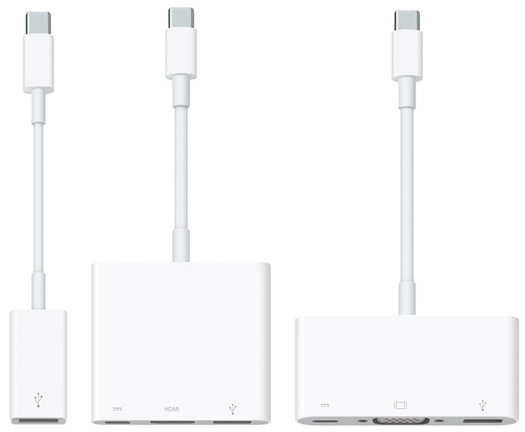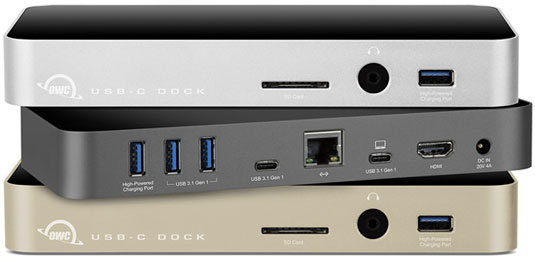Hosted by site sponsor WebMate.
Retina MacBook Q&A
Update Published August 15, 2019
All Mac Q&As >> Retina Display MacBook Q&A (Home)
To be notified of new Q&As, sign up for EveryMac.com's bimonthly email list.
What is USB-C? What adapters are available for the Retina Display MacBook USB-C port?
USB-C is a new version of the "traditional" USB port that Apple first used for the original iMac. Since the original iMac was unveiled in 1998, the USB standard has become faster with USB 2.0 and USB 3.0, but the USB connector on Apple notebooks -- technically a female USB-A port -- has remained the same size and shape and newer standards still are backwards compatible with older ones as a result.
As the 24-pin USB-C connector is roughly one-third of the size of earlier USB standards, it is no longer directly backwards compatible. However, the USB-C connector is both symmetrical and reversible, so both ends of a cable are the same and it can be plugged in with either side up, as well.
The USB-C standard also supports higher wattage charging (up to 100 watts), data transfer (USB 2.0, 5 Gbps as implemented by Apple for the Retina Display MacBook) and DisplayPort 1.2.
The only major disadvantage of USB-C is that it will require a number of ungainly adapters from Apple or a third-party in the short-term, like any new connectivity standard to use with older ports. For those who want to use a Retina Display MacBook with a number of peripherals, a dock also is well worth considering.
Apple has released three different USB-C adapters for the Retina Display MacBook -- the Apple USB-C to USB Adapter (MJ1M2AM/A), Apple USB-C Digital AV Multiport Adapter (MJ1K2AM/A), and Apple USB-C VGA Multiport Adapter (MJ1L2AM/A).

Photo Credit: Apple, Inc. (Apple USB-C Adapters)
The Apple USB-C to USB Adapter (MJ1M2AM/A) is the simplest and cheapest adapter and simply converts a traditional USB port to a USB-C port, but it does not pass power. As the Retina Display MacBook does not have any other relevant ports, you cannot use this adapter and plug the notebook into a power outlet at the same time, which is decidedly limiting.
The Apple USB-C Digital AV Multiport Adapter (MJ1K2AM/A) provides a traditional USB port, an HDMI port, and a power passthrough port to be used with the Apple USB-C power adapter and a two meter USB-C charge cable to charge the notebook.
The Apple USB-C VGA Multiport Adapter (MJ1L2AM/A) provides a traditional USB port, an "old school" VGA port, and a power passthrough port that likewise is to be used with the Apple USB-C power adapter and USB-C charge cable.
Site sponsor Adorama sells all these Apple adapters.
Of course, because USB-C is an industry-standard, there are an abundance of third-party USB-C cables and accessories, as well.
Some third-party adapters like the simple OWC USB Type-A to USB Type-C Adapter, MacAlly USB-C to HDMI Adapter, and MacAlly USB-C to VGA Adapter more-or-less replicate the functionality of the Apple adapters, but are worth considering for those who would like to save a little money.
Others, like the Kanex USB-C to Gigabit Ethernet Adapter provide functionality that is otherwise unavailable from Apple.
Site sponsor OWC sells all these third-party adapters.
If a USB-C adapter is insufficient, or at least less than ideal, a dock also can be worthwhile either for additional connectivity while on the go or for those who like to leave a desk setup with a variety of peripherals and quickly plug in a notebook computer without also having to disconnect and reconnect a bunch of cables.
For the Retina Display MacBook, OWC also sells an inexpensive USB-C Travel Dock, which includes five ports -- a USB-C port (which can be used for pass through power), two "traditional" USB 3.1 (USB-A) ports, an HDMI port, and an SD Card slot (UHS-II).
OWC sells two versions of the USB-C Travel Dock. Both versions offer the same ports, but the first version provides up to 60W of pass through power (sufficient for the Retina MacBook) and the second version provides up to 100W of pass through power and a cable design that tucks underneath the dock for tidier transport.

Photo Credit: OWC, Inc. (USB-C Travel Dock, Not to Scale)
If the USB-C Travel Dock doesn't provide enough options, OWC additionally offers two large USB-C Docks that provide a whopping ten ports.

Photo Credit: OWC, Inc. (USB-C Dock with HDMI, Not to Scale)
One version of the OWC USB-C Dock includes an HDMI port and the other includes a MiniDisplay Port.
On the front, both versions have an SD card slot, headphone jack, and high power USB 3.1 port. On the rear, both versions are differentiated only by the presence of either HDMI or MiniDisplay Port and otherwise share three USB 3.1 ports (one high power and two standard power), one USB-C port (in addition to a USB-C connector to attach the computer itself), a microphone port, a Gigabit Ethernet port, and a DC power connector.
This promo video provides more details:
Although OWC's docks cost more than a single Apple adapter, and are physically larger, each is significantly more versatile, as well.
The full-size OWC USB-C Dock devices even include an 80 watt power adapter that delivers 60 watts of power to the notebook when it is connected to the dock so you could easily leave the notebook's standard power adapter in a bag for easy use while on the go and not even need to take it out and get setup when you reach your dock-equipped home or office.
Likewise, for any of these docks, you would never need to juggle between choosing to connect your Retina MacBook to either power or a peripheral.
In Australia, site sponsor Upgradeable sells OWC's USB-C Dock and other docks with fast shipping across Australia and a money back guarantee.
USB-C Summary
Ultimately, USB-C is smaller, easier-to-use and more versatile than earlier USB standards. As the standard matures, and a multitude of third-party cables, accessories, and devices become available more readily, it will be a welcomed improvement for most users.
Permalink | Report an Error/Typo | Sign Up for Site Update Notices
<< Retina Display MacBook Q&A (Main) | All Mac Q&As
Established in 1996, EveryMac.com has been created by experts with decades of experience with Apple hardware. EveryMac.com includes, and always has included, original research incorporating detailed, hands-on inspection of packaging, computers, and devices as well as extensive real-world use. All information is provided in good faith, but no website or person is perfect. Accordingly, EveryMac.com is provided "as is" without warranty of any kind whatsoever. EveryMac.com, and the authors thereof, shall not be held responsible or liable, under any circumstances, for any damages resulting from the use or inability to use the information within. For complete disclaimer and copyright information please read and understand the Terms of Use and the Privacy Policy before using EveryMac.com. Copying, scraping, or use of any content without expressed permission is not allowed, although links to any page are welcomed and appreciated.
